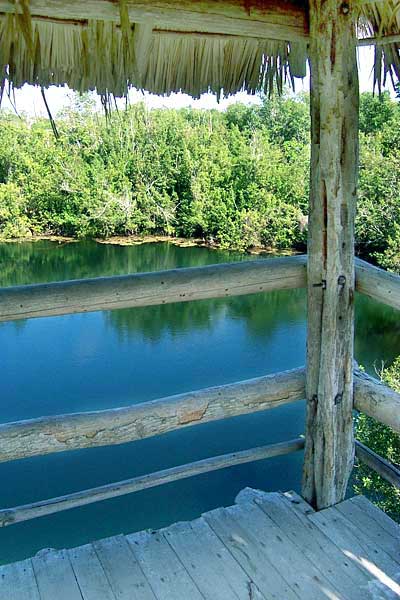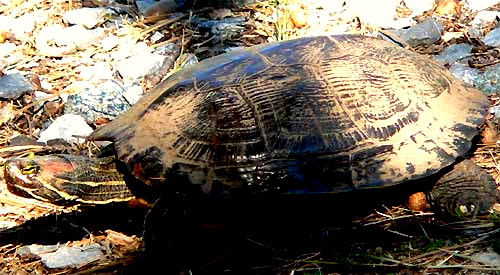Excerpts from Jim Conrad's
Naturalist Newsletter
from the November 27, 2006 Newsletter Issued from Diego Nuñez's office above Restaurante "Isla Contoy," Río Lagartos, on the Yucatan Peninsula's northern coast (~N21.60°, ~W88.16°), Yucatán state, MÉXICO
TURTLE IN A FRESHWATER SPRING

The wildlife-viewing tower at Petén Tucha is quite something. It's built of rough poles and it stands beside an acre-size freshwater spring surrounded by saltwater mangroves. During my first night out I erected my tent on the top level, the tent being needed for mosquitoes despite the wind being so gusty that the tower swayed constantly. In the end, I stayed at the tower for 24 hours. Not a single other person visited there. That's a picture from the top level overlooking the spring at the top of this page
That picture shows how blue the water is. You don't realize how clear it is until you see bubbles coming up from below, and then you watch them rise for so long that you know that they must have become visible many feet below the water's surface.
I also realized the water's clearness when a turtle swam right below me as I sat with my legs dangling over the top level's floor. Since there are no real rivers in the northern Yucatan, turtles are more uncommon here than you might expect, so I was tickled to be getting such a good view of one. I figured that in this remarkable ecosystem -- a freshwater spring surrounded by saltwater mangroves -- it would surely be an exotic species.
But as soon as that turtle poked his head out of the water I saw it: A conspicuous yellow stripe all along the head and neck, with a dingy red stripe above the eye. I'd seen this turtle before, and I've talked about it in this Newsletter. In March of 2002 I reported on eight of them sunning in a springy pond in Mississippi and in October of 2005 I told about one crossing Fred's driveway in California's Sierra Nevadas. It was a Red-eared Turtle, TRACHEMYS SCRIPTA, which I've said before is distributed from southern Michigan and New Mexico south to South America, plus there are introduced populations in Europe, Israel, South Africa and other places. This is the main "pet shop turtle," the turtle that has starved and dried up in a million kids' neglected fishbowls. That's the picture I took at Fred's last year, looking just about exactly like what I saw here, below.

Red-eared Turtles -- called Mesoamerican Sliders by my reptile book for this area -- are a freshwater species, so it's a mystery to me how this turtle got here across the enormous acreage of saltwater mangrove surrounding us.
My book says that Red-ears in this area are preyed upon by Morelet's Crocodiles. I saw at least one Morelet's in Petén Tucha and signs of more. I don't know whether Petén Tucha's clear water will mainly help the crocodile stalk the turtle, or help the Red-ear watch for the croc.